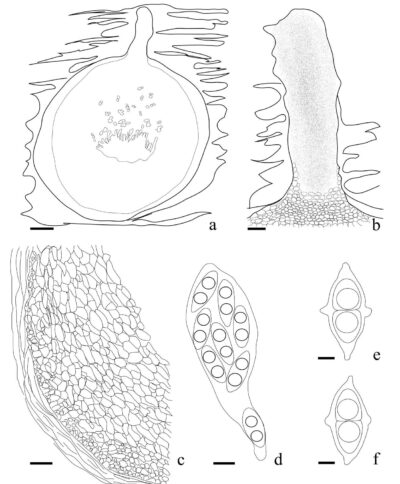Fungalpedia – Note 371, Ebullia
Ebullia K.L. Pang
Citation when using this data: Tibpromma et al. 2024 (in prep.) – Fungalpedia, Ascomycota.
Index Fungorum, Facesoffungi; MycoBank, GenBank, Fig. 1
Classification: Incertae sedis, Halosphaeriales, Hypocreomycetidae, Sordariomycetes, Pezizomycotina, Ascomycota, Fungi.
Based on phylogenies of LSU and SSU analyses and morphological studies, Chu et al. (2015) established Ebullia to accommodate the type species Ebullia octonae (=Nimbospora octonae). Ebullia octonae differ from Nimbospora effusa and N. bipolaris by their thick peridium, and ascospores that lack equatorial tufts of appendages but possess polar and equatorial subulate appendages after the sheath is dissolved (Chu et al. 2015). Ebullia is characterized by subglobose to ampulliform ascomata, immersed, ostiolate, with long necks, periphysate, eight-spored asci, clavate, ellipsoidal ascospores, hyaline, one-septate, not or slightly constricted at the septum, with a gelatinous sheath and one similar appendage at each end, swells in water (Chu et al. 2015). No other species have been introduced to Ebullia, which remains monotypic.
Type species: Ebullia octonae (Kohlm.) K.L. Pang
Other accepted species: This genus is monotypic.
Figure 1 – Ebullia octonae . a Ascoma embedded deeply inside wood with a thick peridium at the basal region. b Ostiole with a long neck. c Thick, two-layered peridium. d Clavate ascus. e, f Ascospores with a sheath that extends in seawater. Scale bars: a = 100 μm, b = 25 μm, c = 20 μm, d = 10 μm, e, f = 5 μm. Redrawn from Chu et al. (2015).
Reference
Entry by
Du TY, Center for Yunnan Plateau Biological Resources Protection and Utilization, College of Biological Resource and Food Engineering, Qujing Normal University, Qujing, Yunnan 655011, China; Center of Excellence in Fungal Research, Mae Fah Luang University, Chiang Rai 57100, Thailand; School of Science, Mae Fah Luang University, Chiang Rai 57100, Thailand.
(Edited by Saowaluck Tibpromma, Samaneh Chaharmiri-Dokhaharani, & Achala R. Rathnayaka)
Published online 25 November 2024
